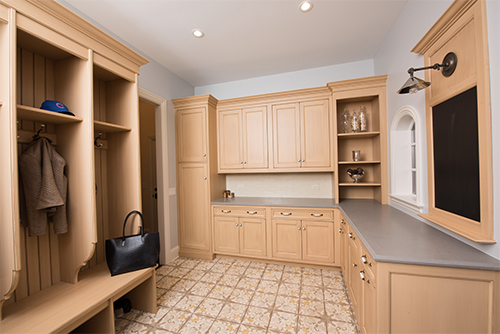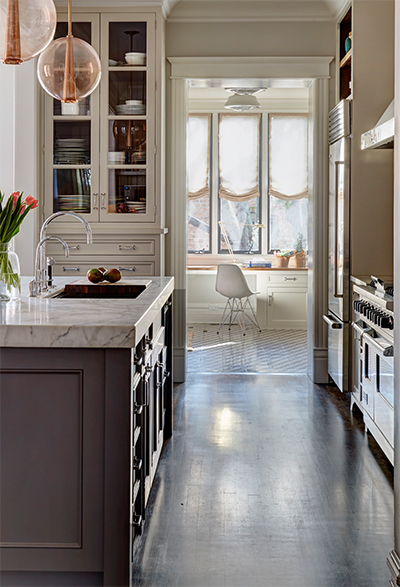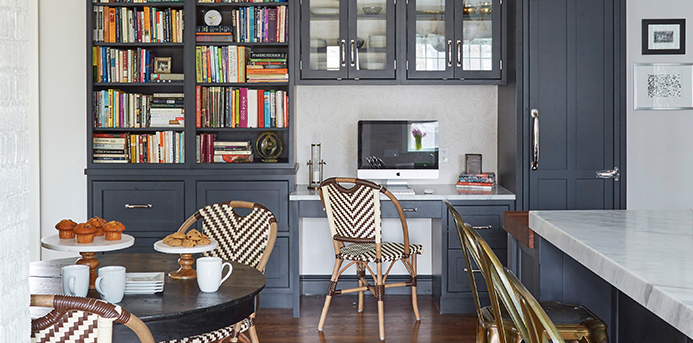Every parent knows there just aren’t enough hours in the day. In fact, a recent Pew Research Center poll found that 40 percent of working mothers and 34 percent of working fathers with children under age 18 said they always feel rushed. How to cope? Get organized, particularly as the school year begins.
Pinterest is full of cute ideas to declutter small parts of the house, but with working parents already feeling the grind, setting aside time to organize via the DIY-crafts route may not be the best way to go. That strategy leaves plenty of room for half-finished organizing projects, which of course defeats the purpose entirely.
Set your busy family up for success this school year by creating well-organized, kid-friendly spaces in your home where you can tame the chaos and tackle your daily tasks with maximum comfort and efficiency.
“Launch Pad”/Mudroom

With the start of school comes all the equipment — backpacks, binders and notebooks, to start — that keeps children organized at school. Add to that some sports gear, coats and boots, and your back entryway could become a disaster area.
Instead, introduce a “locker system” to organize your mudroom into a “launch pad,” suggests Ann Schref, associate manager with Walter E. Smithe Furniture & Design in Chicago.
These aren’t lockers in the traditional sense, but rather built-in cabinets or freestanding shelves that can be designed to fit the style of the home. Using wood tones that match the wood in the next room (often a kitchen) can pack a stylistic punch and make the space look finished rather than cluttered, Schref says. She also recommends putting in a bench where children can don boots and coats and have “dedicated space to get ready.”
Longtime Make It Better writer Lisa Zimbler worked with five-time “Best Of” Best Builder winner A. Perry Homes to create the perfect mudroom in her Glenview home. “We designed the room to be both aesthetically pleasing as well as a functional space for storage,” Zimbler says. “Everyone has a cubby for their coats and shoes, and there are plenty of additional cabinet spaces to store cleaning and laundry supplies.”
Rebekah Zaveloff, co-founder and director of design for KitchenLab Design in Chicago, takes another tack: Create an organized space in the mudroom area that goes beyond the traditional drop-your-stuff-here attitude.
“We try to figure out the best use for an old space to create spaces that are a little more integrated and attractive and sort of multi-use,” Zaveloff says.
Yes, keep the cubbies and hooks, but add lots of drawers, perhaps for crafts if the room is big enough. Less-used outdoor equipment could hide behind a custom door. But, most importantly, “don’t underestimate the power of a simple bench that you can kick all your shoes under,” Zaveloff says. “It can be a lifesaver.”
An important tip from Zeveloff: Keep your front entryway in mind as you design your mudroom space. Remember, most guests will use that area to enter the home, so it should have an organized put-your-things-here space as well, to avoid overloaded coat trees and guests’ shoes strewn about.

Homework Hub
Creating a dedicated homework space could mean the difference between success and struggle for some students. According to a 2015 study by the University of Salford in Manchester, England, environmental factors including lighting, temperature, and space customization can make a big difference in student performance.
So, instead of having the kids work from their bedrooms or at the kitchen table, take a corner of the house and make a space specifically for homework and projects. Schref says her clients often want two things from their desk space: uncluttered computer/paperwork area and hutch storage above the desk.
“Things don’t have to be super organized, but can be more categorized — a place for writing implements, another for paper — so it’s not as structured,” Schref says. “But parents will like that because everything will look neat and tidy.”
Be sure this space is equipped with electronic hookups (enough for several tech appliances, including desktop computer, laptop, iPad, phone and e-book), as well as baskets and drawers for storage and a dedicated file area to keep kids’ various homework assignments and projects organized. Horizontal surface is important, of course, to allow room for electronics, books and writing space.
If it’s possible, position this space so it’s not far from an adult’s evening recreation area, perhaps in a corner of or just outside a multipurpose room. That way, the parent can be in the room reading or quietly watching television while the student is in that space doing homework.

“Nerve Center”
As school — and life in general — becomes more tech-focused, areas formerly known as “message centers” or “mail zones” are transitioning as well. While these areas are still positioned near the most-used entryway to the home and include places for keys, mail and (now much rarer) phone messages, these spaces now should act as “nerve centers,” or charging stations, says Zaveloff.
Usually, it’s a cabinet designed specifically to hold these items, with plentiful outlet availability inside or just behind the cabinet, placed close enough to the door that it would be relatively easy to run back into the house to grab your keys or phone should you leave them by accident.
“Whether it’s a table at the entry or some area that’s designated for it in the mudroom or kitchen, just be really strict about it” to keep clutter off other horizontal spaces and ensure you can always find your keys, wallet, phone and other important take-along items, Schref says. “Hold firm to that space and it will be very beneficial.”
Reading Nook
Is your formal living room used twice a year and otherwise ignored to collect dust? Consider turning it into a reading room, Schref advises. “Do bookcases across the back wall with a cozy reading area, ottoman, small sofa — it can be a library,” she says. “That ignored room, we’re seeing transformation of that space from formal to more of a reading nook area.” Despite a trend toward e-readers, people still have a lot of books, Schref says. Instead of letting those clutter other areas of the home, put them in an order of your choosing on large shelves in that room, then add a few photos, some art, or a couple of family treasures. Creating a comfortable sitting room that’s not focused on the television may encourage children to read more during the school year.
“That’s one way for family to take back that area,” Schref says. “People are taking their square footage seriously, and want to make each space very usable in their homes.”
Pin this post:
More from Make It Better:
- Best of 2017: Home & Design
- Marie Kondo: How to Change Your Life Through Tidying
- Sean Conlon Talks CNBC’s ‘The Deed: Chicago’ and Making It in Real Estate

Megan Craig has been a journalist for more than a decade, writing and editing stories on a variety of subjects. Most recently, her writing has focused on real estate trends in the Midwest and around the country. She lives in Chicago’s Printers Row neighborhood with her roommate and a few too many cats.


